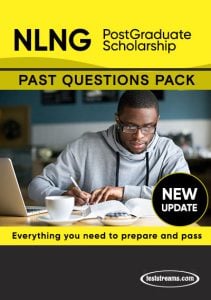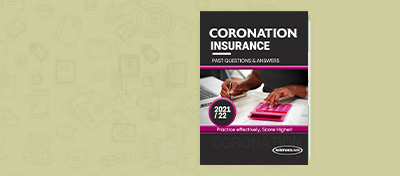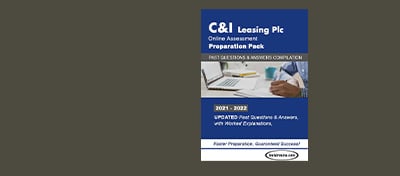Can you ace these NLNG Postgraduate Scholarship Past Questions? Start honing your skills with some past questions practice and get a preview of what you can expect on test day.
We pulled theseNLNG Postgraduate Scholarship job questions from our study pack NLNG Postgraduate Scholarship Past Questions 2022 Each sample question includes correct answers, so you can see how to crack it!
Sample NLNG Job Aptitude Test Past Questions and answers
Question 1
How many patients from this sample have suffered from depression in 1995?
A. 1150 patients
B. 1155 patients
C. 1375 patients
D. 1455 patients
E. 1535 patients
Correct answer: C
Explanation
55% of the 1995 sample suffered from depression. The sample consists of 2500 participants ?
0.55 = 1,375 patients suffered from depression in 1995.
Question 2
From the sample, how many less patients suffered from Bipolar disorder between 2000 and
2005?
A. 225 patients
B. 250 patients
C. 350 patients
D. 375 patients
E. 400 patients
Correct answer: B
Explanation
In 2000, 15% of the sample (2500) suffered from Bipolar disorder= 2500 x 0.15 = 375 patients. In
2005, 5% of the sample (2500) suffered from Bipolar disorder = 2500 x 0.05 = 125 patients.
375-125=250 less patients suffered from Bipolar disorder in 2005 than in 2000.
An additional way to do the math is simply look at the graph and note the difference in
percentages between 2005 and 2000 which is 10% (15-5).
10% of the entire sample (2500) is 250 and we can calculate this without making use of a
calculator
Question 3
A new revolutionary medication is introduced in 2005. This medication immediately alleviates
symptoms for 20% of the patients suffering from the 4 mental disorders presented here.
Assuming that, starting from 2005, such a treatment will be given to the original sample every 5
years with an identical success rate in percentages, how many patients comprising the sample
will remain mentally ill by the year 2020?
A. 1,024 Patients
B. 1,048 Patients
C. 1,280 Patients
D. 1,000 Patients
E. 2,000 Patients
Correct answer: A
Explanation
The medication is introduced in 2005 reducing mental illness for a sample of 2500 by 20% = 0.2 x
2500 = 500 cured patients and a total of 2000 (2500 ? 500) patients remain ill.
In 2010 another 20% will be cured from the remaining group of mentally ill people in the original
sample (2000) = 0.2 x 2000 = 400 additional patients cured and a total of 1600 (2000-400)
remaining ill.
In 2015 another 20% will be cured from a remaining sample of 1600= 0.2 x 1600 = 320 additional
patients cured and a total of 1280 (1600-320) remaining ill.
In 2020 another 20% will be cured from a remaining sample of 1280 = 0.2 x 1280 = 256 additional
patients cured and a total of 1024 (1280-256) patients still remain ill.
Question 4
In the following 15 years it is expected that the trends seen from 2000 onwards for Anxiety and
OCD will continue at the same rate. What will be the expected ratio between the two in the
year 2020?
A. 2:5
B. 1:2
C. 1:3
D. 2:3
E. 1:1
Correct answer: E
Explanation
Between 2000 to 2005 there was a reduction of 5% from 30% to 25% of patients suffering from
Anxiety.
In the same time frame the prevalence of OCD remained 10%.
Assuming this trend continues, OCD will remain constant at 10% while Anxiety is expected to
loose 5% every 5 years. i.e., drop from 25% in 2005, to 20% in 2010, to 15% in 2015, and finally to
10% in 2020.
The ratio of Anxiety to OCD in 2020 assuming the present trend continues will be 1:1
(10%:10%).
Question 5
Rate the ratio of Depression to OCD patients in the sample from largest to smallest by years.
A. 1985, 1990, 1995, 2000, 2005
B. 1990, 1985, 1995, 2005, 2000
C. 2000, 2005, 1995, 1985, 1990
D. 1990, 2000,1995, 1985,2005
E. 2000, 2005, 1985, 1990, 1995
Correct answer: B
Explanation
The Depression to OCD ratio in 1985 = 60% : 5% = 12 :1
The Depression to OCD ratio in 1990 = 65% : 5% = 13:1
The Depression to OCD ratio in 1995 = 55% : 5% = 11:1
The Depression to OCD ratio in 2000 = 45% : 10% = 4.5:1 = 9:2
The Depression to OCD ratio in 2005 = 60% : 10% = 6:1
Therefore, putting the ratio in order from largest to smallest by years = 1990, 1985, 1995, 2005,
200
TestStreams.com
If you need support on your study materials or just to ask us a question, You can chat with a Teststreams support agent using the live chat link below, or send us a quick in-mail.





